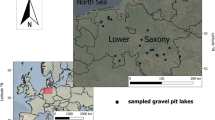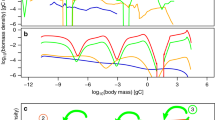Abstract
The extent to which ecosystems are regulated by top-down relative to bottom-up control has been a dominant paradigm in ecology for many decades. For lakes, it has been shown that predation by fish is an important determinant of variation in zooplankton and phytoplankton community characteristics. Effects of fish are expected to not only be a function of total fish biomass, but also of functional composition of the fish community. Previous research on the importance of trophic cascades in lakes has largely focused on the role of zooplanktivorous and piscivorous fish. We conducted a large-scale multiple-lake fish community manipulation experiment to test for the effect of differences in fish functional community composition on the trophic structure of lakes. We examine the effect of top-down and bottom-up factors on phytoplankton and zooplankton biomass as well as on their community composition. We put our data in a broader perspective by comparing our results to data of a survey that also included ponds with low fish densities as well as ponds with very high densities of fish. Our results indicate that the overall food web structure under relative high fish densities is primarily structured by bottom-up factors, whereas community characteristics seem to be primarily regulated by top-down factors. Our results suggest a subtle interplay between bottom-up and top-down factors, in which bottom-up factors dominate in determining quantities while top-down effects are important in determining identities of the communities.


Similar content being viewed by others
References
Attayde JL, Hansson L-A. 2001. Fish-mediated nutrient recycling and the trophic cascade in lakes. Canadian Journal of Fisheries and Aquatic Sciences 58:1924–31.
Barton K. 2011. MuMIn: Multi-model inference. R package version 1.0. 0. Vienna, Austria: R Foundation for Statistical Computing. See http://CRAN.R-project.org/package=MuMIn.
Berg S, Jeppesen E, Søndergaard M. 1997. Pike (Esox lucius L.) stocking as a biomanipulation tool 1. Effects on the fish population in Lake Lyng. Denmark. Hydrobiologia 342:311–18.
Blanchet FG, Legendre P, Borcard D. 2008. Forward selection of explanatory variables. Ecology 89:2623–32.
Bottrell H, Duncan A, Gliwicz Z, Grygierek E, Herzig A, Hillbricht-Ilkowska A, Kurasawa H, Larsson P, Weglenska T. 1976. A review of some problems in zooplankton production studies. Norwegian Journal of Zoology 24:416–56.
Breukelaar AW, Lammens EHHR, Klein Breteler JGB, Tátrai I. 1994. Effects of benthivorous bream (Abramis brama) and carp (Cyprius carpio) on sediment resuspension and concentration of nutrients and chlorophyll-a. Freshwater Biology 32:113–21.
Brooks JH, Dodson SI. 1965. Predation, body size and composition of plankton. Science 150:28–35.
Burnham KP, Anderson DR. 2002. Model selection and multimodel inference: a practical information-theoretic approach: Springer.
Carpenter SR, Cole JJ, Hodgson JR, Kitchell JF, Pace ML, Bade D, Cottingham KL, Essington TE, Houser JN, Schindler DE. 2001. Trophic cascades, nutrients, and lake productivity: whole-lake experiments. Ecological Monographs 71:163–86.
Carpenter SR, Cole JJ, Pace ML, Wilkinson GM. 2015. Response of plankton to nutrients, planktivory and terrestrial organic matter: a model analysis of whole-lake experiments. Ecology Letters in press.
Carpenter SR, Kitchell JF. 1996. The trophic cascade in lakes: Cambridge University Press.
Carpenter SR, Kitchell JF, Cottingham KL, Schindler DE, Christense DL, Post DM, Voichick N. 1996. Chlorophyll variability, nutrient input, and grazing: evidence from whole-lake experiments. Ecology 77:725–35.
Carpenter SR, Kitchell JF, Hodgson JR. 1985. Cascading Trophic Interactions and Lake Productivity. BioScience 35:634–9.
Cline JM, East TL, Threlkeld ST. 1994. Fish interactions with the sediment-water interface. Hydrobiologia 275:301–11.
Declerck S, De Meester L. 2003. Impact of fish predation on coexisting Daphnia taxa: a partial test of the temporal hybrid superiority hypothesis. Aquatic Biodiversity: Springer. pp 83–94.
DeLong JP, Gilbert B, Shurin JB, Savage VM, Barton BT, Clements CF, Dell AI, Greig HS, Harley CD, Kratina P. 2015. The body size dependence of trophic cascades. The American Naturalist 185:354–66.
Elser JJ, Andersen T, Baron JS, Bergström A-K, Jansson M, Kyle M, Nydick KR, Steger L, Hessen DO. 2009. Shifts in lake N: P stoichiometry and nutrient limitation driven by atmospheric nitrogen deposition. Science 326:835–7.
Elser JJ, Bracken ME, Cleland EE, Gruner DS, Harpole WS, Hillebrand H, Ngai JT, Seabloom EW, Shurin JB, Smith JE. 2007. Global analysis of nitrogen and phosphorus limitation of primary producers in freshwater, marine and terrestrial ecosystems. Ecology Letters 10:1135–42.
Flössner D. 2000. Die Haplopoda und Cladocera Mitteleuropas Leiden: Backhuys Publishers.
Giam X, Olden JD. 2016. Quantifying variable importance in a multimodel inference framework. Methods in Ecology and Evolution 7:388–97.
Hairston NG, Smith FE, Slobodkin LB. 1960. Community structure, population control, and competition. American Naturalist 94:421–5.
Hansson L-A, Nicolle A, Brodersen J, Romare P, Nilsson P, Brönmark C, Skov C. 2007. Consequences of fish predation, migration, and juvenile ontogeny on zooplankton spring dynamics. Limnology and Oceanography 52:696–706.
Harpole WS, Ngai JT, Cleland EE, Seabloom EW, Borer ET, Bracken ME, Elser JJ, Gruner DS, Hillebrand H, Shurin JB. 2011. Nutrient co-limitation of primary producer communities. Ecology Letters 14:852–62.
Havens KE. 1991. Fish-induced sediment resuspension: effects on phytoplankton biomass and community structure in a shallow hypereutrophic lake. Journal of Plankton Research 13:1163–76.
Jeppesen E, Jensen JP, Jensen C, Faafeng B, Hessen DO, Søndergaard M, Lauridsen T, Brettum P, Christoffersen K. 2003. The impact of nutrient state and lake depth on top-down control in the pelagic zone of lakes: a study of 466 lakes from the temperate zone to the arctic. Ecosystems 6:313–25.
Jeppesen E, Jensen JP, Søndergaard M, Lauridsen T, Pedersen LJ, Jensen L. 1997. Top-down control in freshwater lakes: the role of nutrient state, submerged macrophytes and water depth. Hydrobiologia 342–343:151–64.
Jeppesen E, Meerhoff M, Jacobsen BA, Hansen RS, Søndergaard M, Jensen JP, Lauridsen TL, Mazzeo N, Branco CWC. 2007. Restoration of shallow lakes by nutrient control and biomanipulation—the successful strategy varies with lake size and climate. Hydrobiologia 581:269–85.
John DM, Whitton BA, Brook AJ. 2002. The freshwater algal flora of the British isles. Cambridge: Cambridge University Press.
Jones JI, Sayer CD. 2003. Does the fish-invertebrate-periphyton cascade precipitate plan loss in shallow lakes? Ecology 84:2155–67.
Kerfoot WC, Sih A. 1987. Predation: direct and indirect impacts on aquatic communities: University Press of New England.
Koroleff F. 1970. Determination of total phosphorus in natural waters by means of persulphate oxidation. Interlaboratory report No. 3, Le Conseil International pour l’exploration de la mer (ICES, Pap. CM 1969/C.8, 1970 (1969–1970), p54.
Lampert W, Fleckner W, Rai H, Taylor BE. 1986. Phytoplankton control by grazing zooplankton: a study on the spring clear-water phase. Limnology and Oceanography 31:478–90.
Lemmens P, De Meester L, Declerck SAJ. 2016. Can underwater refuges protect fish populations against cormorant predation? Evidence from a large scale multiple pond experiment. Fisheries Management and Ecology 23:89–98.
Lemmens P, Mergeay J, De Bie T, Van Wichelen J, De Meester L, Declerck SAJ. 2013. How to Maximally Support Local and Regional Biodiversity in Applied Conservation? Insights from Pond Management. PLoS One 8:e72538.
Lougheed VL, Crosbie B, Chow-Fraser P. 1998. Predictions on the effect of common carp (Cyprinus carpio) exclusion on water quality, zooplankton, and submergent macrophytes in a Great Lakes wetland. Canadian Journal of Fisheries and Aquatic Sciences 55:1189–97.
Meijer M-L, De Haan M, Breukelaar A, Buiteveld H. 1990. Is reduction of the benthivorous fish an important cause of high transparency following biomanipulation in shallow lakes?. Biomanipulation Tool for Water Management: Springer. pp 303–15.
Miller SA, Crowl TA. 2006. Effects of common carp (Cyprinus carpio) on macrophytes and invertebrate communities in a shallow lake. Freshwater Biology 51:85–94.
Moss B, Jeppesen E, Søndergaard M, Lauridsen TL, Liu Z. 2013. Nitrogen, macrophytes, shallow lakes and nutrient limitation: resolution of a current controversy? Hydrobiologia 710:3–21.
O’Brien RM. 2007. A caution regarding rules of thumb for variance inflation factors. Quality & Quantity 41:673–90.
Oksanen J, Blanchet F, Kindt R, Legendre P, O’Hara R, Simpson G, Solymos P, Stevens M, Wagner H. 2010. vegan: Community Ecology Package. R package version 1.17-1. R package version: 1.17-16.
Ozimek T, Gulati RD, van Donk E. 1990. Can macrophytes be useful in biomanipulation of lakes? The Lake Zwemlust example. Biomanipulation Tool for Water Management: Springer. pp 399–407.
Parkos JJIII, Santucci J, Victor J, Wahl DH. 2003. Effects of adult common carp (Cyprinus carpio) on multiple trophic levels in shallow mesocosms. Canadian Journal of Fisheries and Aquatic Sciences 60:182–92.
Perrow MR, Meijer M-L, Dawidowicz P, Coops H. 1997. Biomanipulation in shallow lakes: state of the art. Hydrobiologia 342–343:355–65.
Persson L, Diehl S, Johansson L, Andersson G, Hamrin SF. 1992. Trophic interactions in temperate lake ecosystems: a test of food chain theory. American Naturalist 140:59–84.
Petrusek A, Hobaek A, Nilssen JP, Skage M, ČErný M, Brede N, Schwenk K. 2008a. A taxonomic reappraisal of the European Daphnia longispina complex (Crustacea, Cladocera, Anomopoda). Zoologica Scripta 37:507–19.
Petrusek A, Seda J, Macháček J, Ruthová Š, Šmilauer P. 2008b. Daphnia hybridization along ecological gradients in pelagic environments: the potential for the presence of hybrid zones in plankton. Philosophical Transactions of the Royal Society B: Biological Sciences 363:2931–41.
Potthoff AJ, Herwig BR, Hanson MA, Zimmer KD, Butler MG, Reed JR, Parsons BG, Ward MC. 2008. Cascading food-web effects of piscivore introductions in shallow lakes. Journal of Applied Ecology 45:1170–9.
Power ME. 1992. Top-down and bottom-up forces in food webs: do plants have primacy. Ecology 73:733–46.
Quirós R. 1997. Fish effects on trophic relationships in the pelagic zone of lakes. Hydrobiologia 361:101–11.
R Development Core Team. 2013. R: A language and environment for statistical computing. R Foundation for Statistical Computing Vienna, Austria: http://www.R-project.org.
Scheffer M. 1998. Ecology of shallow lakes. London: Chapman and Hall.
Scheffer M, Hosper SH, Meijer ML, Moss B, Jeppesen E. 1993. Alternative equilibria in shallow lakes. Trends in Ecology & Evolution 8:275–9.
Schindler D. 1977. Evolution of phosphorus limitation in lakes. Science 195:260–2.
Schindler DW. 2012. The dilemma of controlling cultural eutrophication of lakes. Proceedings of the Royal Society B: Biological Sciences 279:4322–33.
Shapiro J, Lamarra VA, Lynch M. 1975. Biomanipulation: an ecosystem approach to lake restoration. Brezonik PL, Fox JL editors. Proceedings of a Symposium on Water Quality Management Through Biological Control. Gainesville: University of Florida.
Søndergaard M, Jeppesen E, Lauridsen TL, Skov C, Van Nes EH, Roijackers R, Lammens E, Portielje R. 2007. Lake restoration: successes, failures and long-term effects. Journal of Applied Ecology 44:1095–105.
Sterner RW, Elser JJ. 2002. Ecological stoichiometry: the biology of elements from molecules to the biosphere: Princeton University Press.
Symonds MR, Moussalli A. 2011. A brief guide to model selection, multimodel inference and model averaging in behavioural ecology using Akaike’s information criterion. Behavioral Ecology and Sociobiology 65:13–21.
Vanni MJ. 1987. Effects of nutrients and zooplankton size on the structure of a phytoplankton community. Ecology 68:624–35.
Venables WN, Ripley BD. 2002. Modern Applied Statistics with S. New York: Springer.
Xu H, Paerl HW, Qin B, Zhu G, Gao G. 2010. Nitrogen and phosphorus inputs control phytoplankton growth in eutrophic Lake Taihu. China. Limnology and Oceanography 55:420.
Zambrano L, Hinojosa D. 1999. Direct and indirect effects of carp (Cyprinus carpio L.) on macrophyte and benthic communities in experimental shallow ponds in central Mexico. Hydrobiologia 408(409):131–8.
Zambrano L, Scheffer M, Martínez-Ramos M. 2001. Catastrophic response of lakes to benthivorous fish introduction. Oikos 94:344–50.
Acknowledgements
We are grateful to the local fish farmers for their help with the fish stock assessments, and we thank Kevin Hoovelts for his assistance in the field. This study was funded by the Agency for Nature and Forests via a national TWOL project (LIM/AMINAL/AN/LIM/2004/10), and by BioDivERsA project TIPPINGPOND (nationally funded by Belspo). PL enjoyed a grant from the Institute for the Promotion of Innovation through Science and Technology in Flanders (IWT-Flanders).
Author information
Authors and Affiliations
Corresponding author
Additional information
Author Contributions
PL, SAJD, MV and LDM conceived and designed the study. PL, KT and MV carried out the experiment. PL analyzed the data. PL, SAJD, KT, MV and LDM wrote the paper.
Electronic supplementary material
Below is the link to the electronic supplementary material.
Rights and permissions
About this article
Cite this article
Lemmens, P., Declerck, S.A.J., Tuytens, K. et al. Bottom-Up Effects on Biomass Versus Top-Down Effects on Identity: A Multiple-Lake Fish Community Manipulation Experiment. Ecosystems 21, 166–177 (2018). https://doi.org/10.1007/s10021-017-0144-x
Received:
Accepted:
Published:
Issue Date:
DOI: https://doi.org/10.1007/s10021-017-0144-x




